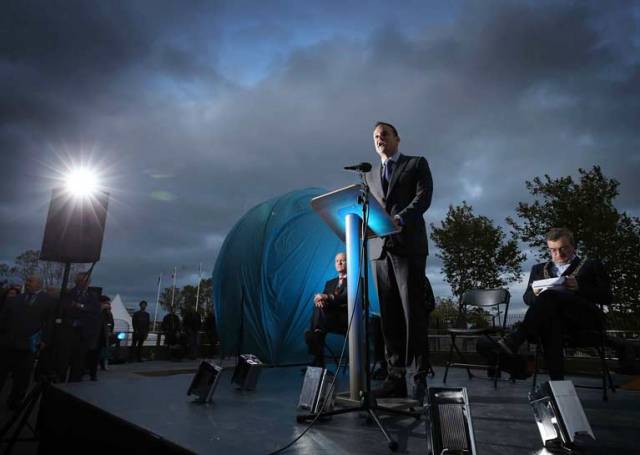Guests of Honour Ardmhéara Bhaile Átha Cliath and Honorary Admiral of Dublin Port, Mícheál Mac Donncha and An Taoiseach Mr. Leo Varadkar TD were in attendance at the official opening of Dublin Port Centre. The project which began last November marks the largest physical intervention by Dublin Port to reintegrate the Port with the City, as committed to in the company’s Masterplan. The project has softened the Port’s boundaries to the City and provides public realm at Port Centre for the first time in 35 years.
MC’d by well-known broadcaster Eileen Dunne the 500-strong crowd, which was made up of members from the communities surrounding the Port, was serenaded by acts including Damien Dempsey, John Sheahan of the Dubliners, The Blades, Lisa O’ Neill, Colm Mac Con Iomaire of The Frames and Catherine Fitzgerald, many of whom were featured in Dublin Port’s 2016 album “Starboard Home”.
Speaking at the official opening ceremony the Ardmhéara, Mícheál Mac Donncha said: “It is a great honour to officially open Dublin Port Centre. The Port is such a huge part of Dublin City’s life and I believe with this project finally completed that connection is set to become stronger and stronger.”
Commenting at the event, Eamonn O’Reilly, Chief Executive, Dublin Port Company said: “Dublin Port is delighted to begin this new chapter of Port City integration. In recent years the connection has waned somewhat but this a new era for the Port. Rebuilding the connection between the Port and the City, which was so strong a century ago, is something which will be at the core of everything we do going forward.”
Speaking at the event, An Taoiseach Mr. Leo Varadkar TD said: “While Dublin Port’s key focus is on its infrastructural development and the import and export needs of the Irish economy, it also has a strong commitment to rebuilding the linkages between the port and the city. This new project will enhance Port-city integration to the benefit of city dwellers and visitors.
“Dublin Port is at the heart of what is emerging as one of the most exciting neighbourhoods in the city, and the opening of this port centre will add to the buzz and energy of this area, as well as providing locals with a host of new amenities to enjoy.”
Port Centre has been a hive of activity in recent months as the development of public space progressed. Projects included the removal of a section of the existing old boundary wall to create new pedestrian entry points at Alexandra Road and East Wall Road. Earlier this month the Port unveiled Crane 292 a newly restored crane from the 1960s which now stands proudly towering over Port Centre.
Visitors can now enjoy a landscaped “maritime” garden with seats for reflection and relaxation. NCAD graduate and up and coming Irish artist Eimear Murphy’s new sculpture ‘The Drop’ features in the garden. The sculpture is made from solid concrete and plays with notions of fluidity in its design. The commissioning of this piece highlights the Port’s long-term commitment to supporting the arts.
Dublin Port Company is now focused on plans for a new internal road network, cycle lanes and pathways. Approved by Dublin City Council and scheduled for development, the three-kilometre route will give pedestrians and cyclists access to the Port estate for recreational use for the first time. It includes a perimeter route with vantage points overlooking the Tolka Estuary.































































